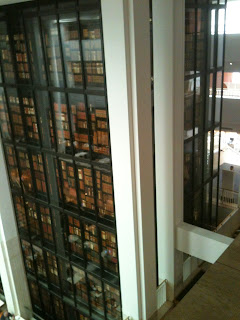Thursday, July 3, 2014
Academic Day 4: British Library
A modern sculpture of Sir Issac Newton...I see an inspiration of both Auguste Rodin's sculpture-work and Sir William Blake's picture prints...yet, somewhat unfortunatelly, named by locals, "Newton on the Toilet"!
Kevin Mehmet, Welcome Team Officer of the British Library as well as a Donated Acquisitions Officer, met our group at the door and gave us a brief history of the library beneath the busts of several instrumental figures in the establishment of the institution. Most notably for my future research was the likeness of Sir Hans Sloane, although this was but the first time his name had been uttered to me. Mr. Mehmet then showed us the library's stamp collection which is tidily stored in thin pull out vertical drawers, which gives maximum access, yet takes up minimum space.
After walking through the World War I exhibit, a common theme throughout this month, which marked the 100th anniversary of Archduke Ferdinand's assassination, we stopped by a model replica of the new British Library building. Truly an anomoly amongst the historic buildings of London, this low-impact modern design of horizontal lines resembles a ship on the water.
Mr. Mehmet suggested that the architect was never able to attain the rank of Captain in the military, so he designed this structure as his one true ship to endure time and carry knowledge on its journey.
We walked into the main office to be granted a 'Readers Card' (Library Card) and Mr. Mehmet told us exactly how to go about it and what information is needed. This proved to be a very empowering lesson for me, because I was later able to duplicate his lesson and get my own readers card for my research paper research, with minimal discomfort...I had trepidation to do research there, having preconcieved notions that this country's national library would be 'stuffy' and difficult to navigate. My concerns were unfounded: the staff was very eagre to assist me and although the working librarians, in their individual rooms, are very business-like (and quite loud, I may add!), once I got the hang of it, the whole place is truly laid back and easy to work in.
Mr. Mehmet then took us behind the scenes and showed us what was entailed in the ordering and transfer of books through miles of conveyor-belt systems.
We then got to walk out on an observation balcony to experience two of the multi-level reading rooms from above. We were then taken back through the maze of offices and then Mr. Mehmet finally told me the answer to my initial question of 'What is your job title'! He delayed the question for a long time, which added to his very witty and charming humor. He described his job as being an acquisition's officer for items written in several different languages. Although he can't read those languages, he has specialists working with him to ascertain what the library would benefit from having and what should be allowed to slip away, as Shakespeare's First Folio did many years ago!
The Glass Tower of Books which dominates the enormous entry hall of the building was one of the last items to be described, as being the endowment of King George III, in perpetuity to the institution as long as it was wholly displayed to the public and fully accessable to anyone who wants to partake of its knowledge. This architectural feature was designed to bring the King's wishes into the 21st Century.
Our group ended at "The Treasure Room" which is the public viewing space for the most rare artifacts of the British Library. Contemporaraneous copies of the Magna Carta, notebooks of DiVinci and Durer, musical pieces handwritten by Beethoven, Mozart, and Hayden, glorious illuminated manuscripts, holy writings from around the world, an enourmous globe, and rough notes on scraps of paper written by The Beatles of some of their greatest hits, including 'Help'! On the tour, this was the only room we were not allowed to take photographs in.
One of the many book benches throughout London. This library awareness raising campaign placed these handsomely substantial metal benches in public spaces. This was the only example I saw of one not painted, although it was the only one I saw with additional metalwork, in this case, being the ball-and-chain. The dozen or more I stumbled onto during my stay in London were all beautifully painted to reflect different themes.
Subscribe to:
Post Comments (Atom)










No comments:
Post a Comment